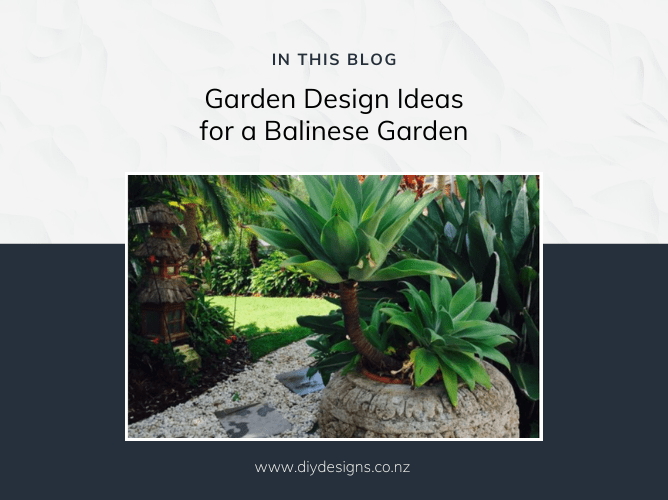Garden design ideas for a Balinese garden
Garden design ideas for a Balinese garden – search this term and you will find results ranging from a contemporary resort-style aesthetic to rustic, aged settings. This makes the Balinese Garden a versatile garden design theme, easily recreated in many garden contexts.
Whatever your aesthetic, these verdant, tropical-looking gardens create an atmosphere of peace and tranquillity, making them the perfect choice if you are also looking for garden design ideas for a ‘holiday at home’ garden makeover. With this popular travel destination currently out of reach for most of us, now is a great time ring some of those garden design ideas to life and create your own Balinese paradise.
You can get creative with your own interpretation of the Balinese garden. Just be sure to incorporate the key design elements and ideas of this garden style.
Balinese Garden Design
Balinese garden design includes some essential design elements:
Foliage: An abundance of lush green foliage is one of the essential design elements in a Balinese garden design. Top plants you could include:
- Natural materials: This is one of the areas where subtropical gardens and Balinese garden design ideas differ. Subtropical gardens often incorporate elements made with man-materials such as steel (fences, panels and louvred roofs) along with things like glass pool fences and fibreglass pots and planters. Balinese garden design ideas, however, will typically include items fabricated using natural materials such as timber, stone & pebbles, bamboo and thatch, rather than man-made materials.
- Bamboo: Great for screening and privacy. Choose a clustering variety rather than a spreading one or contain it in a large pot or planter.
- Palms: If the thought of using bamboo in your garden design makes your toes curl, look to bamboo-like palms such as Chamadorea costericana instead. Use a variety of palms (there are many to select from so research what works best in your area) and include different forms to create a layered effect including canopy, understorey and screening.
- Bananas: These can grow in temperate regions and have the perfect foliage form, it’s unlikely to bear fruit, but the large leaves more than makeup for it in this style of garden design.
- Bird of Paradise: Many strelitzia have a similar large leafy form to the banana, with the bonus of large, exotic ‘bird-like‘ blooms.
- Leafy foliage: Balinese garden design in New Zealand provides an opportunity to use many of our gorgeous native plants in a way that allows them to attain there naturally large, leafy forms. Pseudopnax, griselinia, mahoe, kohokohe and puka are all worthy contenders.
- Ferns: Whatever your local climate, there will be a range of ferns suitable for a Balinese garden theme. Include these in your garden design as thickly planted groundcover to provide foliage contrast, and to keep pesky weeds at bay.
- Flowers: With your lush green foliage base sorted, another essential design element to incorporate in your Balinese garden design is flowers. Flower ‘beds’ are rare in Balinese gardens, rather they are designed to reflect nature and flowering plants are used as colourful, accent features. If brightly coloured flowers aren’t your thing, design your garden to incorporate plants with smaller blossoms that can discreetly provide sweetly scented blooms. White flowering plants typically offer the most perfume as they lack the colourful flowers that there more flashy counterparts use to attract pollinating insects, relying on their scent instead. Flowering plants that offer plenty of green work well in this type of garden design – consider Frangipani, Jasmine, Strelitzia (Bird of Paradise), Spathiphyllum (Peace Lily). Vireya rhododendron. Lotus and Water Lily.
Natural materials: This is one of the areas where subtropical gardens and Balinese garden design ideas differ. Subtropical gardens often incorporate elements made with man-materials such as steel (fences, panels and louvred roofs) along with things like glass pool fences and fibreglass pots and planters. Balinese garden design ideas, however, will typically include items fabricated using natural materials such as timber, stone & pebbles, bamboo and thatch, rather than man-made materials.
Shade: A Balinese style garden usually features a design idea to create shade – usually a gazebo or a covered pergola area. Thatched roof structures are popular. Avoid plastic, glass or canvas to get ‘the look’.
Intimacy: Balinese gardens offer places for quiet reflection or meditation. This makes them the ideal choice for small gardens, or intimate nooks in a larger garden.
Water: Balinese garden design ideas typically incorporate water in some form.
Statuary / Ornamentation: Balinese statuary is usually Hindu; however, Buddhist or any other stone ornamentation that will evoke a sense of tranquillity and peace will work.
Balinese Garden - Design Ideas
Balinese Garden design incorporates the ideas and elements above, so keeping those in mind, consider how your current favourite ideas and plants may work in your space. If you have a large back garden, you may want to choose a limited area to work with and create a Balinese ‘room’ or retreat space within the bigger garden.
- Start with a focal point or centrepiece for the garden. Design ideas for this could include the gazebo or the essential water feature. Even a spa pool (hot tubs work well) tucked into lush planting can form a water-based focal point for your Balinese garden and will create an ideal environment for relaxation.
- If space is limited, consider more modest design ideas for your focal point, such a water fountain or water bowl, Balinese garden statue or a large ornamental pot. Balinese style garden ornaments have become so popular you can now find them at most garden centres or specialty outlets.
- Once you have a focal point to work around, place seating close to or within view of it, creating a quiet sitting spot. Stone or timber benches are ideal.
- Now consider ideas as to how you are going to access your seating area and move around the garden in general. Stone steps and natural stone or pebbled paths make ideal Balinese garden paths. If you are using large stones, space them apart instead of creating a continuous pathway. Forcing the taking of measured steps is a subtle garden design trick to slow down your pace and help you relax as you move into and through your garden space.
- That forms the structure of your garden, and now you can add your preferred plants. Just consider what purpose the plant needs to serve, then incorporate the right type of plants to provide the things you still need - such as screening, backdrop, canopy, colour and groundcover. Remember to include fragrant plants in key spots, such as near the edge of a path or by your seating.
- Relax and enjoy!

